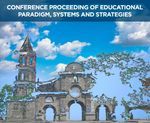1
1
2014
1682060026819_1415
97-97
https://conpro.icepss.net/index.php/CPEPSS/article/download/31/22
https://conpro.icepss.net/index.php/CPEPSS/article/view/31
Attachment Injury Marital Quality Attachment styles Attachment Injury Marital Quality Attachment styles
Marital distress or breakup in couple’s relationships does not happen suddenly, so will understanding of attachment injury in relation to individual’s marital quality and attachment style being help practitioners to be equipped for appropriate and effective inventions.
Therefore, Attachment Injury (AI) is defined as “a specific incident or event in which one partner is unresponsive and/or inaccessible when other partner cries out for help in extreme need” (Johnson & Makinen, 2001).
The literature supports that an individual’s attachment styles may have an impact on the sustainability and quality of couple relationships (Johnson & Whiffen, 1999; Mikulincer et al., 2002). It also supports that adult attachment style predicts functioning in intimate relationships (Lussier et al., 1997; Gallo & Smith, 2001; Hazarika, 2004). Therefore, AI is predicted as depending factor for legal or emotional separation in couples. And attachment style might contribute to AI and marital distress in couples.
Previous studies of attachment injuries (Millikin, 2000; Naaman et al., 2005; Pelling & Buchanan, 2004), observed the process of change in mildly to moderately distressed couples. And the prevalence of marital distress has been reported in 1/2 to 2/3 of all marriages which are likely to lead to separation and/or divorce (Kreider & Fields, 2001).
Hence, this study aimed at examining the incidences of attachment injury and its effect on marital quality. And role of attachment style with and without attachment Injury in married heterosexual couples.
Method: Cross-sectional exploratory design with a set of self-administered measures. With a sample size of 400 married for minimum 5 years, either gender, age between 25 and 50 years. The tools used to assess were:
Attachment Injury Inventory (AII) constructed based on the relationship questionnaires of Holmes et al., 1990 and Collins, 1996
Marital Quality Scale (MQS) (Shah, 1995)
Relationship Scales Questionnaire (RSQ) (Griffin & Bartholomew, 1994)
The study was conducted in two phases: pilot and main phase. During this phase, location of the study, tools for assessment, order of their administration and time required for assessment were established using ten volunteers.
The following operational procedure was employed for the main phase: Announcement was randomly displayed in open places, like nurseries, schools, colleges, social organization and public forum. A brief preliminary interview were held on telephone or email to ascertain that the persons meet the study criteria, and the eligible participants thus selected were given an appointment depending on their convenience to meet up in-person and to administer various measures following written consent. Depending on the availability of the participants, the study measures were completed in one to two sessions. The responses were scored and interpreted as per the instructions in the respective manuals.
Results: There were 266 females and 132 males who were aged between 25 and 50 years from Bangalore urban population. The largest category of sample was from the age group of 36 to 45 years. Majority of the individual were educated and employed and were following Hindu religion. The screening measure for attachment injury pointed out that 96 (24%) individuals were having attachment injury (AI+) and 304 with no-attachment injury (AI-). Majority of the participants had secure and fearful attachment style.
It was also observed that those who reported having AI tend to go through problems such as frequent arguments, thought of divorce and separation in relationship.
Table 1: Mean (SD) score on Marital Quality Scale (MQS) in Attachment Injury (AI +) and no Attachment Injury (AI -) groups (n=96 and 304, respectively)
Overall, MQ has a significant role in AI (t =-9.31, p <0.05). All subscales of MQS such as Understanding, Rejection, Satisfaction, Affection, despair, Decision Making, Role functioning, Discontent, Dissolution potentials, Dominance, Self disclosure, Trust and total score on MQS differ
significantly (p<0.05), on both groups. It was also observed that three subscales i.e. Understanding, Rejection and Affections scored high in comparison to other subscales in AI+ group.
Table 2: Correlation between groups on Attachment Injury Inventory (AII) & Relationship Scale Questionnaire (RSQ) in poor Marital Quality (MQ-) group
Attachment injury group had a positive correlation with attachment styles of the participants that had poor marital quality. . This implies that individuals with insecure attachment style, especially those with preoccupied, dismissive and fearful style, are related to attachment injury (Johnson & Whiffen; 1999).
Another significance difference that emerged across the participants was gender of the injured partner on two components that is trust with t-value = -2.48 and p value = <0.05. The t-value was estimated to be -3.13 with p value at < 0.05. This implies that females tend to experience attachment injury more in comparison to males (Wanic & Kulik, 2011; Naaman et al; 2005).
Chart 1: Qualitative result
As per this study, parental abuse/personal abuse/emotional neglect emerged as the biggest reason for attachment injury. It was followed by financial reasons & behavioural issues.
Limitations
The study was conducted on only one of the injuried partner’s attachment styles and marital quality. Research was based on retrospective accounts; therefore, the participants could have been influenced by reconstructive memory.
Fourthly, since this was a cross-sectional study that utilized lifetime measures of AI and self- reports of past-year marital distress, we were unable to posit directional effects (i.e., from distress to psychopathology vs. from psychopathology to distress).
The variables included in this study were self-reports rather than observational measures.
Rural population not included and unequal proportion between male & female population could be the limitation of this study.
Strength* Adequate sample size.
- Comparable numbers of males and females.
- Homogenous sample – not differing in their background characteristics, like age, duration of
marriage, religion, occupations and education at baseline. This adds to the efficacy of the assessment outcome.
- Selected tools were appropriate and found to be efficient in the Indian settings as confirmed
by other researchers.
- Individual administration of tools.
- Both quantitative and qualitative analyses have been used.
Conclusion Attachment injury and non-attachment injury are more likely to be related to attachment style and marital quality. The findings of the study, therefore, indicate the prevalence of attachment injury in the studied population that is at least one-fourth of the population might be experiencing attachment injury. Hence, it might be possible forth couple therapists or mental health worker to come across individuals who might be experiencing attachment injury.
Conclusion
Attachment injury and non-attachment injury are more likely to be related to attachment style and marital quality. The findings of the study, therefore, indicate the prevalence of attachment injury in the studied population that is at least one-fourth of the population might be experiencing attachment injury. Hence, it might be possible forth couple therapists or mental health worker to come across individuals who might be experiencing attachment injury.
- While assessing couple’s concerns, the present study highlights certain important factors for therapist, like the marital quality, gender and their attachment style to be taken into account while dealing with such persons. Based on the attachment style, further intervention strategies and effective programs should be designed for marital counselling. Hence, marital enrichment programs may be useful to enhance the marital quality to prevent marital distress or breakups.
- Future researchers should examine the attachment injury in real life situations involving participants’ actual close relationship partners. A longer follow up with a longitudinal design in large number of sample in similar research conditions would tell whether attachment injury event caused poor marital quality or if it was the result of poor marital quality.
References
Collins, N. L. (1996). Working Models of Attachment: Implications for Explanation Emotion, and Behavior. Journal of Personality and Social Psychology, 71(4), 810-832.
Gallo, C.B., & Smith, W.T. (2001). Attachment Style in Marriage: Adjustment and Responses to Interaction. Journal of Social and Personal Relationships, 18 (2), 263-289.
Griffin, D., Bartholomew, K. (1994). Models of the self and other: Fundamental dimensions underlying measures of adult attachment. Journal of Personality and Social Psychology, 67(3), 430-445.
Hazarika, M. (2004). Attachment Style, Self esteem and Quality of Marital Life. Unpublished M.Phil thesis. NIMHANS, Bangalore.
Holmes, J. G., Boon, S. D., & Adams, S. (1990). The Relationship Trust Scale. Unpublished manuscript. University of Waterloo, Waterloo, Canada.
Johnson, M.S.,& Makinen, A J (2001) Attachment Injuries in Couple Relationships: A New Perspective on Impasses in Couple’s Theory. Journal of marital and family therapy. 27(2), 145-155.
Johnson, M.S. (2004).The Practice of Emotional Focused Couple Therapy- second edition: Creating Connection. New York, Taylor & Francis Group.
Johnson, M .S., & Whiffen, E. V. (1999). Made to Measure: Adapting Emotional Focused Couple Therapy to Partners’ Attachment Styles. Clinical Psychology: Science and Practice, 6(4), 366- 381.
Kreider, M., & Fields, M..(2002). Number, Timing, and Duration of Marriages and Divorces: 1996. Household Economic Studies. U.S. Census Bureau.
Lussier, Y., Sabourin, S., & Turgeon, C.(1997). Coping Strategies as Moderators of the Relationship between Attachment and Marital Adjustment. Journal of Social and Personal Relationships, 14(6), 777- 791.
Millikin, M.J.(2000). Resolving Attachment Injuries in Couples Using Emotionally Focused Therapy: A Process Study. Unpublished Doctoral dissertation.Virginia Polytechnic Institute and State University.
Naaman, S., Pappas, J. D., Makinen, J., Zuccarini, D., & Johnson, S. (2005). Treating Attachment Injured couples with Emotionally Focused Therapy: A Case Study approach. Psychiatry: Interpersonal & Biological Processes, 68(1), 55-77.
Pelling, C., & Buchanan, M.A. (2004). Experience of Attachment Injury in Heterosexual Couples Relationships. Canadian Journal of Counselling. 38(4), 289-303.
Shah, A. (1995) Clinical validity of the Marital Quality Scale. NIMHANS Journal, 13(1), 23–31.
Wanic, R., & Kulik, J.(2011). Toward an Understanding of Gender Differences in the Impact of Marital Conflict on Health. Sex Roles, 65, 297-312.
| Article Title | Authors | Vol Info | Year |
| Article Title | Authors | Vol Info | Year |

